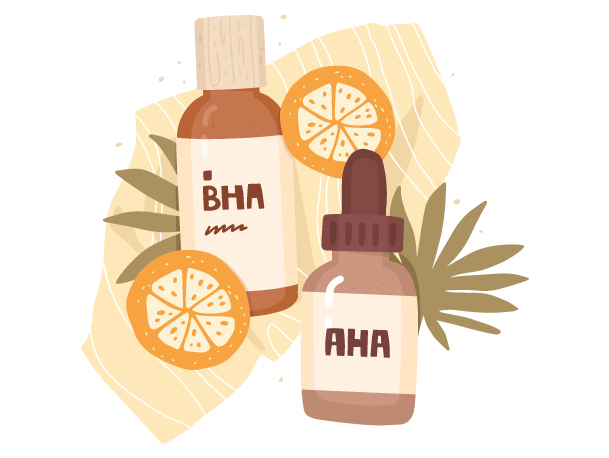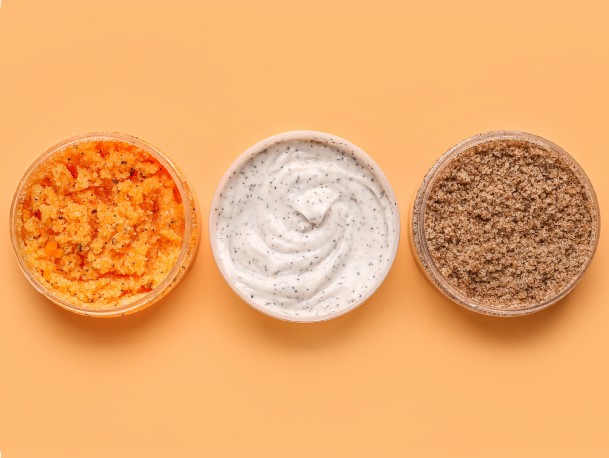Estimated Reading Time: About 5-6 minutes
- Benefits of Exfoliating Your Face
- How to Choose The Right Exfoliator
- How to Exfoliate Your Face
- How Often Should You Exfoliate
- Key Takeaways
- Read More Blog Posts
Exfoliation is a beneficial step in a skin care routine due to its ability to support the skin’s natural turnover process. Whether you choose a physical exfoliant (a scrub or tool that you manually work into your skin) or a chemical exfoliant (skin-safe acids that you apply to your face), exfoliating is a great way to slough off build-up and reveal soft, glowing, and healthy-looking skin. However, it is important to know how to exfoliate your face safely and find the methods and frequency that supports your unique skin type. Continue reading to learn the different types of exfoliations, and tips for exfoliating your face at home.
BENEFITS OF EXFOLIATING YOUR FACE
Exfoliation is the process of removing dead skin cells from the outer layer of the skin. It is an additional step that cleanses even deeper than your typical cleanser removing the excess buildup that can be left behind. Exfoliation helps brighten your complexion and allows your serums and lotions to penetrate deeper into the skin, making them more effective. It also makes the skin feel significantly softer and can help prevent breakouts, since the buildup of dead skin cells can trigger acne flare-ups. Since there are two main forms of exfoliation, incorporating it into a skincare routine can be beneficial for all skin types, especially for oily, acne-prone, and mature skin types, since exfoliation encourages skin cell turnover and improves circulation.
HOW TO CHOOSE THE RIGHT EXFOLIATOR

Choosing the right exfoliator for your skin type is very important, since the wrong type of exfoliation can cause irritation, further dryness, and even damage to the skin. The two types of exfoliators include mechanical/physical and chemical. Chemical exfoliators include alpha hydroxy acids (AHAs) or beta hydroxy acids (BHAs) that break down the barrier that holds the skin cells together, further promoting cell turnover.
Choosing the right exfoliator for your skin type is very important, since the wrong type of exfoliation can cause irritation, further dryness, and even damage to the skin.
Mechanical or physical exfoliators include scrubs or tools to physically remove the dead skin cells. Scrubs typically include skin exfoliants such as apricot shells, ground walnuts, pumice, jojoba beads, and oatmeal. Physical exfoliators also include tools such as a washcloth, rotating cleansing brush, exfoliation sponge, and exfoliation glove, which are recommended for body exfoliation.

Dry, sensitive, or acne-prone skin types may benefit from a mild chemical exfoliator applied with a washcloth, as physical exfoliation may be too irritating. Meanwhile, those with oily skin can benefit from adding a physical exfoliator to their routine. For those with darker skin tones, more aggressive forms of exfoliation are not recommended, as they may trigger dark spots on the skin.
HOW TO EXFOLIATE YOUR FACE (PREP, DURING AND AFTER)
Prior to adding exfoliation to your skin care routine, it is important to consider the skin care product you are already using. If you are using strong over-the-counter products or even taking certain medications, your skin may be more sensitive to exfoliants. Prescription retinoid creams and products containing retinol or benzoyl peroxide may worsen dryness or even trigger breakouts.
When using a physical exfoliator or a scrub, apply the product gently using small, circular motions. Exfoliate for up to 30 seconds, then rinse your face with lukewarm water. When exfoliating with a brush or a sponge, use short, light stroking motions. Never exfoliate if your skin has any open cuts, wounds, or if your skin is sunburned.
Once you have finished the exfoliation step, it is important to follow up with moisturizer. Exfoliating can be drying, so moisturizing will protect the skin’s moisture barrier while leaving the skin soft and supple.
How to Exfoliate for Dry Skin
Exfoliation is important for dry or flaky skin. However, physical exfoliators and scrubs can exacerbate dryness and lead to microtears. AHAs and glycolic acid are recommended for dry skin due to their ability to remove dead skin cells and encourage healthy skin turnover. After exfoliating, follow up with a moisturizer and SPF, since glycolic acid can make skin more sensitive to harmful UV rays.
How to Exfoliate Sensitive Skin
Those with sensitive skin should avoid scrubs and physical exfoliators, and instead use mild chemical exfoliators. AHAs such as glycolic, lactic, or mandelic acid are gentle enough to use on sensitive skin in low concentrations. Apply with a gentle washcloth no more than once a week.
How to Exfoliate Oily Skin
Oily skin may benefit from incorporating physical exfoliation and brushing due to the extra layer of buildup. Gently exfoliate with a scrub in circular motions up to twice a week. Chemical exfoliators such as salicylic acid solutions or BHAs are also effective for oily skin.
How to Exfoliate Normal Skin
Physical and chemical exfoliators are safe enough for use on normal skin types that don’t experience any complications. Those with normal skin may need to experiment with both types of exfoliators to find the right fit.
Combination Skin
Combination skin may require a mix of physical and chemical exfoliators in their routine. Avoid using both on the same day, as this can cause irritation. Use a moisturizer immediately after to treat tightness and prevent dryness.
HOW OFTEN SHOULD YOU EXFOLIATE YOUR FACE
Both chemical and physical exfoliants can be very strong, and the stronger an exfoliant is, the less often it needs to be used. Signs of over-exfoliating include redness, irritation and peeling or flaking of the skin.
Finding the right schedule for exfoliating depends on your skin type, as well as the type of exfoliator you are using. If you have sensitive skin and you choose to exfoliate, use a creamy cleanser with a low concentration of an AHA such as glycolic acid once a week. Those with oily skin can get away with exfoliating more often, since this skin type deals with excess sebum production. Gradually working up to exfoliating four times per week is recommended, and oily skin can benefit from both chemical and mechanical exfoliators. For normal to combination skin, exfoliating twice a week is recommended using a retinoid, an AHA, or a BHA cleanser.
Finding the right schedule for exfoliating depends on your skin type, as well as the type of exfoliator you are using. Signs of over-exfoliating include redness, irritation and peeling or flaking of the skin.
If you have acne-prone skin or are experiencing a breakout, it is recommended to avoid strong physical exfoliants. This is because skin is already inflamed and treating trouble spots with harsh exfoliators can cause post-inflammatory hyperpigmentation. Those with deeper skin tones are especially prone to these types of dark spots.
KEY TAKEAWAYS
- Exfoliation Methods: There are two types of exfoliators: physical (scrubs, brushes) and chemical (AHAs, BHAs). Choosing the right method depends on your skin type.
- Skin Type Considerations:
- Dry and sensitive skin benefit from gentle chemical exfoliators like AHAs.
- Oily skin can handle both physical and chemical exfoliation more frequently.
- Combination skin may require alternating between methods.
- Frequency: How often you exfoliate should be tailored to your skin type. For sensitive skin, once a week is ideal, while oily skin can tolerate up to four times per week.
- Moisturize After: Always follow exfoliation with a moisturizer to maintain skin hydration and protect its barrier.
READ MORE BLOG POSTS
Looking for more ways to treat your skin at home, naturally? Check out the following blog posts:
What are Exfoliants? Benefits and Uses
The Best Natural Alternatives to Petroleum Jelly
